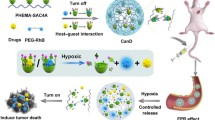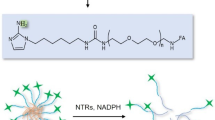Abstract
Chemotherapy is one of the commonly used methods to treat various types of cancers in clinic by virtue of its high efficiency and universality. However, strong side effects and low concentration of conventional drugs at the tumor site have always been important factors that plague the chemotherapy effects of patients, further precluding their practical applications. Thereof, to solve the above dilemma, by integration of anticancer drug (nitrogen mustard, NM) into an NIR fluorophore (a dicyanoisophorone derivative), an intelligent prodrug NIR-NM was developed via molecular engineering strategy. Prodrug NIR-NM stimulated in hypoxia condition exhibits significantly higher toxicity to cancer cells than normal cells, essentially reducing the collateral damage to healthy cells and tissues of nitrogen mustard. More importantly, the nanoparticle prodrug FA-lip@NIR-NM showed the advantages of the high accumulation of drug at tumor site and long-circulation capacity in vivo, which endowed it the ability to track the release of the active chemotherapeutic drug and further treat solid tumors.

Similar content being viewed by others
References
Boulikas T, Vougiouka M. Oncol Rep, 2004, 11: 559–595
Eckford PDW, Sharom FJ. Chem Rev, 2009, 109: 2989–3011
Oun R, Moussa YE, Wheate NJ. Dalton Trans, 2018, 47: 6645–6653
Huang CY, Ju DT, Chang CF, Reddy PM, Velmurugan BK. BioMedicine, 2017, 7: 12–23
Yang QZ, Wang C, Lang L, Zhou Y, Wang H, Shang DJ. Arch Pharm Res, 2013, 36: 1302–1310
Yue J, Liu S, Wang R, Hu X, Xie Z, Huang Y, Jing X. Mol Pharm, 2012, 9: 1919–1931
Li S, Zhang Y, Wang J, Zhao Y, Ji T, Zhao X, Ding Y, Zhao X, Zhao R, Li F, Yang X, Liu S, Liu Z, Lai J, Whittaker AK, Anderson GJ, Wei J, Nie G. Nat Biomed Eng, 2017, 1: 667–679
Xue T, Jia X, Wang J, Xiang J, Wang W, Du J, He Y. Chem Eur J, 2019, 25: 9634–9638
Walsh JC, Lebedev A, Aten E, Madsen K, Marciano L, Kolb HC. Antioxid Redox Sign, 2014, 21: 1516–1554
Apte S. T. Chin F. E. Graves E. Curr Org Synth, 2011, 8: 593–603
Brown JM, Wilson WR. Nat Rev Cancer, 2004, 4: 437–447
Huang J, Wu Y, Zeng F, Wu S. Theranostics, 2019, 9: 7313–7324
Yoon J, Li H, Kim D, Yao Q, Ge H, Chung J, Fan J, Wang J, Peng X. Angew Chem Int Ed, 2020, anie.202009796
He H, Du L, Tan M, Chen Y, Lu L, An Y, Wang Y, Li X, Li B, Shen J, Wu J, Shuai X. Sci China Chem, 2020, 63: 936–945
Verwilst P, Han J, Lee J, Mun S, Kang HG, Kim JS. Biomaterials, 2017, 115: 104–114
Liao D, Johnson RS. Cancer Metastasis Rev, 2007, 26: 281–290
Vaupel P. Oncol, 2008, 13: 21–26
Chang Q, Jurisica I, Do T, Hedley DW. Cancer Res, 2011, 71: 3110–3120
Yan C, Guo Z, Shen Y, Chen Y, Tian H, Zhu WH. Chem Sci, 2018, 9: 4959–4969
Sharma A, Lee MG, Won M, Koo S, Arambula JF, Sessler JL, Chi SG, Kim JS. J Am Chem Soc, 2019, 141: 15611–15618
Xue T, Shen J, Shao K, Wang W, Wu B, He Y. Chem Eur J, 2020, 26: 2521–2528
Li Q, Cao J, Wang Q, Zhang J, Zhu S, Guo Z, Zhu WH. J Mater Chem B, 2019, 7: 1503–1509
Denmeade SR, Jakobsen CM, Janssen S, Khan SR, Garrett ES, Lilja H, Christensen SB, Isaacs JT. J Natl Cancer Institute, 2003, 95: 990–1000
Denmeade SR, Mhaka AM, Rosen DM, Brennen WN, Dalrymple S, Dach I, Olesen C, Gurel B, DeMarzo AM, Wilding G, Carducci MA, Dionne CA, Moller JV, Nissen P, Christensen SB, Isaacs JT. Sci Translational Med, 2012, 4: 140ra86
Liu HW, Hu XX, Li K, Liu Y, Rong Q, Zhu L, Yuan L, Qu FL, Zhang XB, Tan W. Chem Sci, 2017, 8: 7689–7695
Pennacchietti S, Michieli P, Galluzzo M, Mazzone M, Giordano S, Comoglio PM. Cancer Cell, 2003, 3: 347–361
Ballinger JR. Seminars Nucl Med, 2001, 31: 321–329
Vaupel P, Schlenger K, Knoop C, Höckel M. Cancer Res, 1991, 51: 3316–3322
Yang Z, Cao J, He Y, Yang JH, Kim T, Peng X, Kim JS. Chem Soc Rev, 2014, 43: 4563–4601
Silvers WC, Prasai B, Burk DH, Brown ML, McCarley RL. J Am Chem Soc, 2013, 135: 309–314
Kwon N, Cho MK, Park SJ, Kim D, Nam SJ, Cui L, Kim HM, Yoon J. Chem Commun, 2017, 53: 525–528
Peng X, Gao J, Yuan Y, Liu H, Lei W, Li S, Zhang J, Wang S. Bioconjugate Chem, 2019, 30: 2828–2843
Li Y, Sun Y, Li J, Su Q, Yuan W, Dai Y, Han C, Wang Q, Feng W, Li F. J Am Chem Soc, 2015, 137: 6407–6416
Xu F, Li H, Yao Q, Ge H, Fan J, Sun W, Wang J, Peng X. Chem Sci, 2019, 10: 10586–10594
Zhou Y, Maiti M, Sharma A, Won M, Yu L, Miao LX, Shin J, Podder A, Bobba KN, Han J, Bhuniya S, Kim JS. J Control Release, 2018, 288: 14–22
Ding N, Li Z, Tian X, Zhang J, Guo K, Wang P. Chem Commun, 2019, 55: 13172–13175
Biswas S, Rajesh Y, Barman S, Bera M, Paul A, Mandal M, Pradeep Singh ND. Chem Commun, 2018, 54: 7940–7943
Kumar R, Kim EJ, Han J, Lee H, Shin WS, Kim HM, Bhuniya S, Kim JS, Hong KS. Biomaterials, 2016, 104: 119–128
Zhao X, Ha W, Gao K, Shi Y. Anal Chem, 2020, 92: 9039–9047
Feng W, Gao C, Liu W, Ren H, Wang C, Ge K, Li S, Zhou G, Li H, Wang S, Jia G, Li Z, Zhang J. Chem Commun, 2016, 52: 9434–9437
Li B, Liu P, Yan D, Zeng F, Wu S. J Mater Chem B, 2017, 5: 2635–2643
Jangili P, Won M, Kim SJ, Chun J, Shim I, Kang C, Ren WX, Kim JS. ACS Appl Bio Mater, 2019, 2: 3532–3539
Lindahl LM, Fenger-Gron M, Iversen L. J Eur Acad Dermatol Venereol, 2013, 27: 163–168
Kim YH, Martinez G, Varghese A, Hoppe RT. Arch Dermatol, 2003, 139: 165–173
Li H, Yao Q, Sun W, Shao K, Lu Y, Chung J, Kim D, Fan J, Long S, Du J, Li Y, Wang J, Yoon J, Peng X. J Am Chem Soc, 2020, 142: 6381–6389
Li H, Yao Q, Xu F, Xu N, Duan R, Long S, Fan J, Du J, Wang J, Peng X. Biomaterials, 2018, 179: 1–14
Li H, Li Y, Yao Q, Fan J, Sun W, Long S, Shao K, Du J, Wang J, Peng X. Chem Sci, 2019, 10: 1619–1625
Li H, Yao Q, Xu F, Xu N, Sun W, Long S, Du J, Fan J, Wang J, Peng X. Front Chem, 2018, 6: 485
Shi C, Li M, Zhang Z, Yao Q, Shao K, Xu F, Xu N, Li H, Fan J, Sun W, Du J, Long S, Wang J, Peng X. Biomaterials, 2020, 233: 119755
Kohn KW, Spears CL, Doty P. J Mol Biol, 1966, 19: 266–288
Acknowledgements
This work was supported by the National Creative Research Initiative programs of the National Research Foundation of Korea (NRF), the Korean Government (MSIP) (2012R1A3A2048814), the National Natural Science Foundation of China (21421005, 21808028) and the Natural Science Foundation of Liaoning United Fund (U1608222, U1908202).
Author information
Authors and Affiliations
Corresponding authors
Additional information
Conflict of interest
The authors declare no conflict of interest.
Rights and permissions
About this article
Cite this article
Li, H., Yao, Q., Pu, Z. et al. Hypoxia-activatable nano-prodrug for fluorescently tracking drug release in mice. Sci. China Chem. 64, 499–508 (2021). https://doi.org/10.1007/s11426-020-9880-7
Received:
Accepted:
Published:
Issue Date:
DOI: https://doi.org/10.1007/s11426-020-9880-7




